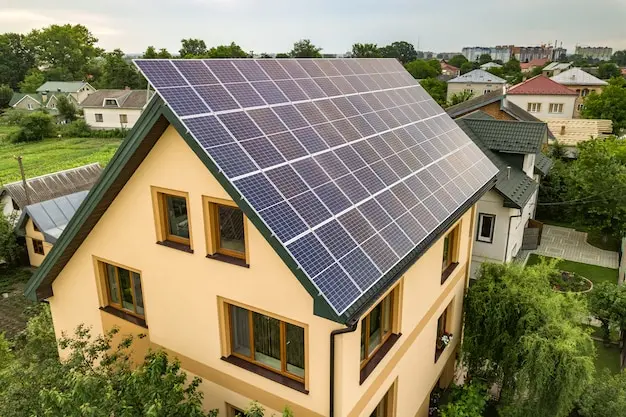In the face of escalating environmental concerns and a growing awareness of our ecological footprint, the concept of sustainable housing has taken center stage. But one question that often arises is, “Is sustainable housing more expensive?” This question, while simple, opens up a broad discussion about the costs, benefits, and long-term implications of sustainable living.
Sustainable housing, also known as eco-friendly housing or green homes, is a method of designing and constructing homes that minimize environmental impact and promotes a healthier living environment. These homes are built with a focus on energy efficiency, reducing waste, and using environmentally friendly materials. But does this focus on sustainability translate into higher costs?
In this blog post, we will delve into the cost of sustainable housing, comparing it with traditional housing, and examining the long-term financial implications. We will explore the various factors that contribute to the cost of sustainable housing, including construction materials, design, and energy efficiency. We will also look at the financial benefits of sustainable housing, such as cost savings and economic advantages.
Whether you’re a newly married couple looking to invest in your first home, a new homeowner curious about green living, or an environmental enthusiast eager to reduce your carbon footprint, this article will provide valuable insights into the cost of sustainable housing.
Stay with us as we unpack the true cost of sustainable housing and answer the question, “Is it more expensive?”
Key Takeaways
- Sustainable housing, while potentially more expensive up front, often proves to be a cost-effective choice in the long run due to energy savings, lower maintenance costs, and higher resale values.
- The environmental benefits of sustainable housing are significant, contributing to reduced energy consumption, water conservation, waste reduction, and a healthier living environment.
- There are many affordable options in sustainable housing, from budget-friendly green homes to simple DIY improvements that can increase the energy efficiency of existing homes.
- Government incentives, rebates, and energy-efficient mortgages can help make sustainable housing more affordable.
- The future of sustainable housing is promising, with increasing awareness, demand, and innovations in green building technologies making sustainable homes more accessible and affordable.
The Perception of Cost in Sustainable Housing
When it comes to sustainable housing, there’s a common perception that ‘green’ equates to ‘expensive.’ This belief stems from the upfront costs associated with building or buying a sustainable home. Advanced features like solar panels, energy-efficient appliances, and high-quality insulation often come with a higher price tag than their conventional counterparts.
However, this is only part of the story. While the initial investment in a sustainable home may be higher, the long-term savings can more than offset these costs. Energy-efficient homes, for instance, can significantly reduce monthly utility bills, leading to substantial savings over time. Furthermore, as the demand for sustainable homes increases, they are likely to appreciate in value, making them a sound investment for the future.
Breaking Down the Cost of Sustainable Housing
To truly understand the cost of sustainable housing, it’s essential to look beyond the initial price tag. While it’s true that the upfront costs of eco-friendly homes can be higher due to the use of specialized materials and technologies, these costs should be viewed as an investment in long-term savings and sustainability.
Let’s break it down:
- Initial Costs: These include the expenses associated with building or buying a sustainable home. They can be higher than conventional homes due to factors such as the use of sustainable construction materials, installation of energy-efficient appliances, and incorporation of renewable energy systems like solar panels.
- Operational Costs: These are the ongoing costs of living in a home, including energy bills, water bills, and maintenance costs. Sustainable homes are designed to be energy-efficient, which can significantly reduce these operational costs. For instance, a well-insulated home requires less energy for heating and cooling, leading to lower energy bills.
- Maintenance Costs: Sustainable homes are often built with high-quality, durable materials that can withstand the test of time. This means less wear and tear and, consequently, lower maintenance costs.
- Resale Value: As awareness and demand for sustainable living increase, green homes are likely to appreciate in value. This means that when it comes time to sell, homeowners can expect a higher return on their investment.
The Financial Benefits of Sustainable Housing
Sustainable housing isn’t just about reducing our environmental impact; it’s also about reaping financial benefits. Energy-efficient homes can lead to significant savings on utility bills. For instance, by using energy-efficient appliances and renewable energy sources, homeowners can drastically cut their energy consumption and, consequently, their energy bills.
Moreover, sustainable homes can offer economic advantages in the form of tax credits and incentives. Many governments and organizations offer financial incentives for homes that meet certain energy efficiency or sustainability standards. These can help offset the initial costs of sustainable housing.
Sustainable Housing and the Environment
The environmental benefits of sustainable housing are profound and far-reaching. By opting for green homes, we can significantly reduce our carbon footprint and contribute to the preservation of our planet. Here’s how:
- Energy Efficiency: Sustainable homes are designed to consume less energy, which not only reduces utility bills but also decreases the demand for energy production, thereby reducing greenhouse gas emissions.
- Water Efficiency: Many sustainable homes incorporate water-saving features such as rainwater collection systems and low-flow fixtures, which help conserve water—a precious and increasingly scarce resource.
- Waste Reduction: The use of sustainable or recycled building materials in construction can significantly reduce waste. Moreover, many green homes include composting systems or other waste-reducing features, further minimizing their environmental impact.
- Healthier Living Environment: Sustainable homes often use non-toxic building materials, which can improve indoor air quality and contribute to a healthier living environment.
Affordable Options in Sustainable Housing
While sustainable housing can be perceived as expensive, there are numerous affordable options available. Low-cost housing can be sustainable too, with many developers now offering budget-friendly homes that incorporate energy efficiency and sustainable design elements.
Moreover, there are various ways to make existing homes more sustainable without breaking the bank. Simple changes like switching to energy-efficient light bulbs, installing a programmable thermostat, or improving insulation can make a significant difference.
The Role of Building Materials in Sustainable Housing
Building materials play a crucial role in sustainable housing. The choice of materials can significantly impact the home’s environmental footprint, its energy efficiency, and, of course, the cost.
Sustainable construction involves the use of materials that are either recycled or have a low environmental impact. These can include reclaimed wood, recycled steel, bamboo, and other eco-friendly materials. While some of these materials may be more expensive upfront, they often offer long-term benefits in the form of durability, energy efficiency, and reduced maintenance costs.
Moreover, the use of locally sourced materials can also contribute to sustainability by reducing transportation emissions and supporting local economies.
Sustainable Housing: A Long-Term Investment
When considering the cost of sustainable housing, it’s essential to look at it as a long-term investment. The initial costs may be higher, but the long-term savings, both financial and environmental, can be substantial.
By investing in energy-efficient appliances, high-quality insulation, and renewable energy sources, homeowners can significantly reduce their monthly utility bills. Over time, these savings can offset the initial investment, making sustainable housing a financially sound choice.
Moreover, sustainable homes often have higher resale values, making them a good investment for the future. As more people become aware of the benefits of sustainable living, the demand for green homes is likely to increase, potentially boosting their market value.
Making Sustainable Housing More Affordable
While the initial costs of sustainable housing can be higher than traditional homes, there are several strategies to make it more affordable:
- Government Incentives and Rebates: Many governments offer incentives, rebates, or tax credits for homes that meet certain energy efficiency or sustainability standards. These can help offset the initial costs of sustainable housing.
- Energy-Efficient Mortgages (EEMs): Some lenders offer Energy-Efficient Mortgages, which factor in the energy savings of a home when determining the loan amount. This can enable buyers to finance energy-efficient homes or make energy-saving improvements to existing homes.
- Green Building Certification: Homes that achieve green building certification, such as LEED or ENERGY STAR, can command higher resale values, making them a good long-term investment.
- DIY Improvements: Simple DIY improvements, such as installing energy-efficient light bulbs, sealing air leaks, and adding insulation, can make a significant difference in a home’s energy efficiency without a large upfront investment.
The Future of Sustainable Housing
As awareness and demand for sustainable living increase, the future of sustainable housing looks promising. Innovations in green building technologies, combined with government incentives and growing consumer demand, are making sustainable homes more accessible and affordable.
Moreover, as the true costs of climate change become more apparent, the value of sustainable housing—both in terms of financial savings and environmental impact—will only become more evident.
Conclusion
In conclusion, while the cost of sustainable housing can be higher upfront, the long-term savings and environmental benefits make it a worthwhile investment. Whether you’re a newly married couple looking for your first home, a new homeowner eager to make sustainable improvements, or an environmentalist passionate about green living, sustainable housing offers a viable and rewarding path toward a more sustainable future.
Remember, every step towards sustainability, no matter how small, makes a difference. So, let’s embrace sustainable living and make our homes part of the solution.
Frequently Asked Questions (FAQs)
-
Is sustainable housing more expensive?
While the initial costs can be higher, sustainable housing often proves to be more cost-effective in the long run due to energy savings, lower maintenance costs, and potential increases in resale value.
-
What are the financial benefits of sustainable housing?
Sustainable housing can lead to significant savings on utility bills, lower maintenance costs, and higher resale values. There are also potential financial incentives, such as government rebates and tax credits for energy-efficient homes.
-
Can sustainable housing be affordable?
Yes, there are many affordable options in sustainable housing. Simple changes like switching to energy-efficient light bulbs, installing a programmable thermostat, or improving insulation can make a significant difference. Additionally, some governments offer incentives and rebates that can help offset the initial costs.
-
What is the future of sustainable housing?
As awareness and demand for sustainable living increase, sustainable housing is becoming more accessible and affordable. Innovations in green building technologies, government incentives, and growing consumer demand are all contributing to a promising future for sustainable housing.

